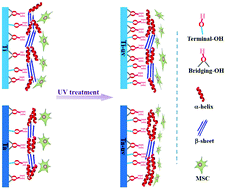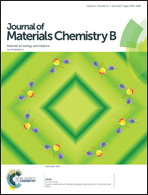Surface hydroxyl groups regulate the osteogenic differentiation of mesenchymal stem cells on titanium and tantalum metals†
Abstract
Titanium (Ti) and tantalum (Ta) metals have been widely used as implants for their favorable mechanical features and good biocompatibility. However, the results on their osteogenic capacity have been conflicting due to the synergistic effects of complex and multiple material surface features (such as topography, surface chemistries etc.) on cellular behaviors. Here, we directly compare the osteogenic response of mesenchymal stem cells (MSCs) to Ti and Ta metal surfaces with alterable surface hydroxyl groups. Although no difference was found on both surface topographies, cellular adhesion, proliferation, and the expression of osteogenic-related markers were upregulated with the increasing amount of surface hydroxyl groups (–OH) after ultraviolet (UV) light treatment. Moreover, Ti showed better effects in promoting osteogenic differentiation of MSCs than Ta before UV light treatment, but demonstrated the opposite after UV light treatment. These results might be attributed to the comparative quantity of the distinct type of surface hydroxyl groups (bridging-OH and terminal-OH), which regulated the conformation of the initial protein adsorption and subsequent cellular behaviors. Our results demonstrate the central role of the surface hydroxyl groups in mediating cell–material interactions and implicate this interface as helping in optimizing osteointegration of Ti and Ta based orthopaedic and dental implants.



 Please wait while we load your content...
Please wait while we load your content...